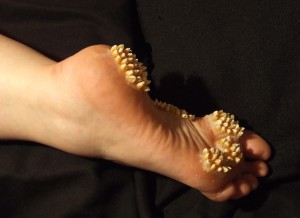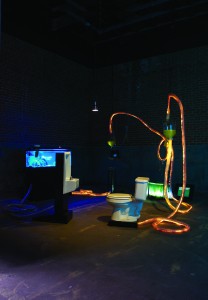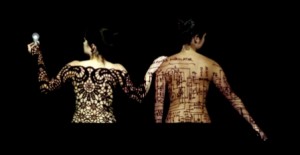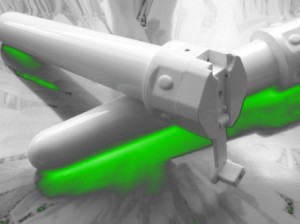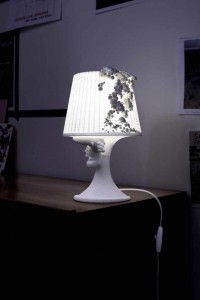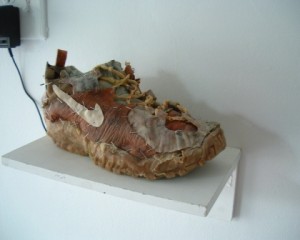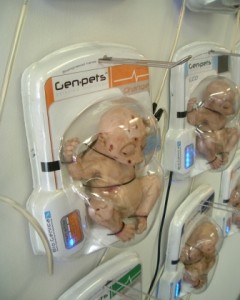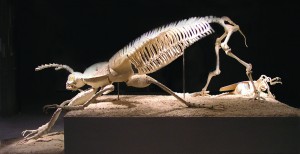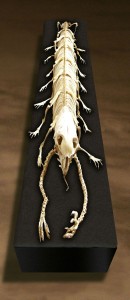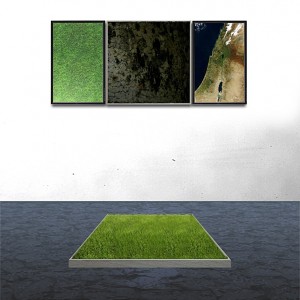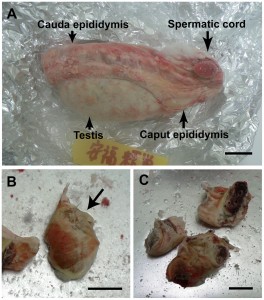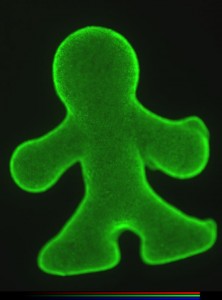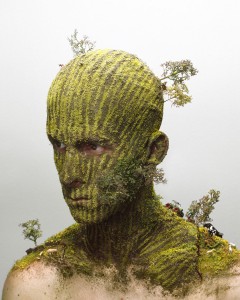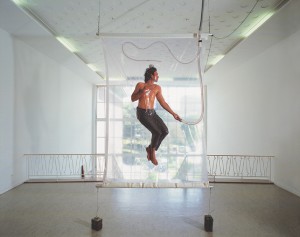
Lawrence Malstaf
http://www.fortlaan17.com
Chance = Change
On the work of Lawrence Malstaf
Luk Van den Dries
The first time I was confronted with the work of Lawrence Malstaf was at a theatre performance. “Sauna in exile” was a project he had done with Mette Edvardsen, Heine Avdal and Liv Hanne Haugen. It had a lasting impression on me. As is the case with all work from Lawrence Malstaf, the starting point is very clear and simple. In the middle of the room there was a sauna that was surrounded with all kinds of chill out zones where you could listen to music, see video performances or just have a drink. But the real heart of the performance is the sauna itself—the genuine article because the visitors have to get into his or her bathrobes to enter the installation. Once naked you surrender yourself to the hot air—and before you know it an equally naked actor introduces you to the use of vihta, tree branches that stimulate your blood flow. A few people even evaporate on the scene and minutes later you witness the start of a choreography.
That choreography also evaporates into the heat and sweat. And right here is the essence of the work: evaporation. Being naked and in bathrobes all difference between ‘visitor’ and ‘actor’ disappears. I am in the sauna, naked and I am on the scene, evaporating. Maybe I even look like an actor if seen from the bar on a higher floor? But is this even important? Isn’t this work just all about your own experience? Nothing in this theatre needs to be told, shown or imagined. It is about different things. The observation of the body by the body and by the people surrounding you. It is the intensity of the senses. How heat and cold change your body and your reactions. This is experience theatre in which you as audience create your own theatre space, in which you are free to do as you please. Theatre on your naked skin.
Central to this experience is the visitor surrendering to the successive heat and cold waves, just like in any real sauna. But this is a sauna squared, a sauna in the fictional theatre space. It is in fact just a representation of a sauna, but this is precisely the deciding factor that provides the extra experience. Being exposed (in different ways) creates different side effects. The visitor enters a liminal zone of seeing and being seen that influences perception and action. It has a delicate and widespread effect on your body that is felt in your smallest veins. It is corporeal because of its sensory perception, but it also influences your self-image and projection. It is a kind of melting consciousness of the self within the context of an interactive installation in which everybody is equal.
This hyper-activation of all your receptors touches the heart of the alchemy of the theatrical representation. The experience is as real and as false as any other theatre night, but it is more violent because of the melting processes that occur and the evaporation of the difference between observation and participation. The fear of being exposed, the consciousness of observing, but especially the observation of the body lead to more inner reflection. It is a kind of corporeal seeing in which every stimulation is experienced by the theatrical display you are a part of. It can be compared to meditating in the rush hour. Trying to reach your inner self in the middle of chaos. It is not just the sauna that is in exile—it is also the visitor that is in and out of his or her body at the same time.
Malstaf did not only design the sauna but also some of the surrounding installations. “Shaft” is one of them: a plastic tube that works like a vacuum cleaner and sucks up different objects. The visitor lies on the sofa underneath the tube and watches as plates float on air until they hit each other and break into pieces. The tension in this installation is created by the contrast between your relaxed body and the floating and breaking plates above your head. Calm and danger delicately balanced. One can see the installation as a metaphor for a comparable situation during a psychiatric session, but the raw effect on the body seems more important here. Relaxation and stress combined. What happens in your perception? Which muscles are tense and which ones are not? How do you channel your fear? These changes in perception are always at the heart of the works of Lawrence Malstaf. He smoothly attacks your skin, ears, balance and vision. He makes you lose your balance and control and gets you breathing differently. In the very moment that your heart skips a beat, Malstaf strikes.
“Shaft” is exemplary for most of the works of Lawrence Malstaf. They are all aimed at sensory deception. Not like Escher with his visual rebus work, but by immersing and exposing the visitor to contrasting impulses. Malstaf invites you to his twilight zone where your pre-programmed perception is challenged. In anthropology this is known as limen (Victor Turner): a transitional stage with its very own rules in which new situations are prepared and tested. These moments are stuck between reality and fiction and are used by Turner to describe the particularity of rituals. Richard Schechner applies liminality to the theatre in which transitional stages are used to see how we can look at man and world. Malstaf approaches liminality in the same way as these great thinkers, he also saves a stage that is different but not detached from reality. He erects glass walls through which you can still vaguely see that reality. In this free stage he invites you to be vulnerable. His installations require submission and sensitivity. Leave your clothes in the dressing room and enter into a world of possibilities.
Dramaturgy of the machine
Malstaf’s interactive installations have their own dramaturgy. They look friendly and comfortable. They look inviting and contemporary. Neatly designed, light and transparent. And then suddenly something inside starts to growl and the friendly installation becomes a mean machine and starts to hiss, suck and turn. The air pressure changes. Invisible valves and pumps start to work. The calm that was is sucked into a turbine, reduced to atoms and spat out. And then suddenly the machine becomes silent yet again, too silent. And you are back in the calm and comfortable surroundings you were in before. Was that just the wind? Or was it someone else who caused my inner storm?
Malstaf’s installations are notably theatrical. Just like Greek drama. Life becomes a mess in just a few minutes. All it takes is a little passion and the whole thing starts to shake. It becomes uncontrollable and everything falls apart. One minute it is caressing you and the next it wants to destroy you. A gentle breeze turns into a hurricane. What looked like a mirror now explodes like a tsunami. The momentum is of the essence, the exact point in time when everything changes. Malstaf stages time like a rotation mechanism. Something starts to shake and sets a whirlpool in motion. It comes to life and starts breathing. The rest is all tragedy.
Malstaf installations deceive the eye. The visitor is always part of the picture. The machine requires a direction of view. In front, underneath or right in the middle. Very rarely above. Malstaf turns the visitor into the object, the submissive part. The machine forces you to take position and then undermines your contemplation. Your mirror image is shattered into a thousand pieces, like in “Mirror” (2002). A renaissance portrait of a woman is sucked away by a vacuum pump, turning the mouth into an outlet pipe of a bath (“Whirlpool”, 1999). Everything around you starts to twirl as if you are in the eye of the storm (“Nemo Observatorium”, 2000). Walls start to move and the room becomes a labyrinth (“Nevel”, 2003). All these tragic machines have their moment of rage, a kind of blindness that reflects the flaws in your own view. This is how they invite you to look inside. But once the rage is over they become vulnerable, drained, and powerless. And then you sit down with some form of shame, in front, inside or underneath. Waiting for that moment when everything changes again.
The Bible and the motor
“Sandbible” is the work that strikes me the most in the Malstaf exposition ‘Freestate’. It is an older work from 1999 that is not an interactive installation. Underneath a sheet of glass you see an open book with a rectangle cut out. In that rectangle there is some sand. Suddenly the machine starts and the sand starts to tremble, forming new figures over and over again. And then the machine stops and the sand finds its peace once again. This clash between that most holy of books and the machine that puts everything in motion is fascinating. The motor strikes at the heart of the Bible. The grains of sand follow their own path in the Bible, forming strange signs, hieroglyphics waiting for the creative reader. The work has several layers in several ways. Some will really feel the hole in the Bible; others will cherish the unlimited amount of signs in the sand.
This work defines Malstaf’s artistic creed because it displays the new technological condition: the motor controls the Bible. The core of Malstaf is the technology he uses. The image is changed by any number of technological applications; it is alienated from its static expression and constantly searches transformation. There is constant experimentation with new technology to show its effect on perception. From that angle the use of all these machines is much more than a gimmick. A work like “Sandbible” hints at a change of paradigm: the laws of physics substitute the law of God. But Malstaf’s metaphysics are exciting and interesting because they are ruled by coincidence. The plates in “Shaft” follow their own path, the grains of sand in “Sandbible” write their own signs. And thus Malstaf’s artistic practice is closely related to the research of physicist Ilya Prygogine and his famous formula: chance = change.
Performances
Thu 3.9. 12:30 – 13:00 & 14:30 – 15:00
Fri 4.9. 12:30 – 13:00 & 14:30 – 15:00
Sat 5.9. 13:00 – 13:30, 14:30 – 15:00 & 16:30 – 17:00
Sun 6.9. 12:30 – 13:00, 14:30 – 15:00 & 16:30 – 17:00
Mon 7.9. 12:30 – 13:00, 14:30 – 15:00 & 16:30 – 17:00
Tue 8.9. 12:30 – 13:00
additional Performers:
Amel Andessner
Elisa Andessner
Nora Riedl
Wolfgang Tragseiler
